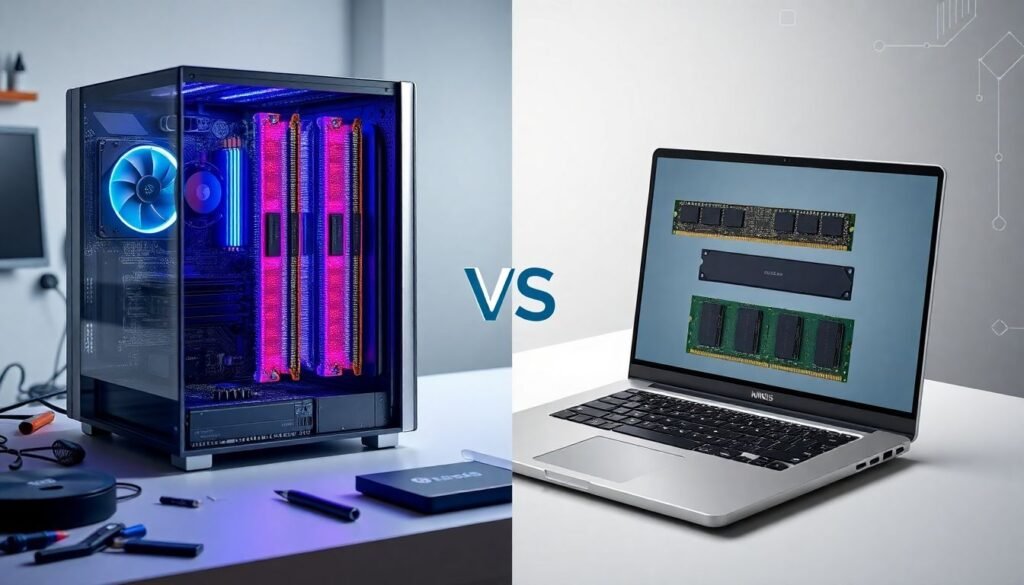
Introduction
RAM, or random access memory, plays a crucial role in how fast your computer runs. Whether you’re gaming, editing videos, or just browsing, your system’s speed depends a lot on its RAM. With so many devices on the market, it’s important to pick the right type of memory for your needs. Misunderstandings about RAM specifications are common, making it confusing to choose the best upgrades or replacements. Knowing the key differences between desktop and laptop RAM helps you avoid compatibility issues and get the most out of your device.
Understanding RAM Basics
What is RAM?
RAM is temporary storage that your computer uses to hold data it needs quickly. The more RAM you have, the more tasks your system can handle at once. It helps your computer stay responsive, especially when running multiple programs or large files.
Types of RAM
There are several generations of DDR SDRAM, including DDR3, DDR4, and DDR5. Newer versions are faster and more efficient but may not work with older hardware. Besides DDR RAM, some devices use LPDDR (low power DDR) or SODIMM, which are smaller forms used mainly in laptops and some compact PCs.
Why RAM Matters for Performance
More RAM means your system can handle larger files or more applications at once. Faster RAM speeds also boost data transfer rates, leading to quicker response times. For gamers, creatives, and professionals, investing in the right RAM makes a noticeable difference.
Physical Differences Between Desktop and Laptop RAM
Form Factors
- Desktop RAM: Uses DIMM modules, which are larger and have more pins. These are common in regular desktop PCs and servers.
- Laptop RAM: Uses SODIMM modules, which are smaller and designed to fit into tight spaces inside laptops and small form-factor computers.
Size and Dimensions
DIMMs typically measure about 5 inches long, while SODIMMs are roughly 2.7 inches. Their size impacts how easily you can upgrade or replace them. Larger modules are straightforward to handle, but smaller ones fit in tight spots.
Pin Counts and Connectors
Desktop DDR4 DIMMs usually have 288 pins, but some older types have 240 pins. Laptop DDR4 SODIMMs often have 260 pins. These differences mean they aren’t interchangeable — your motherboard only accepts one type.
Technical Specifications and Performance Variances
Speed and Frequency
Desktop RAM tends to run at higher MHz ranges, such as 2400 MHz to 3600 MHz. Laptops often use lower speeds like 2133 MHz or 2666 MHz to save power. Higher MHz generally improve data flow, making your system more responsive.
Voltage Differences
Desktop RAM usually requires 1.2V to 1.5V, depending on the type. Laptop RAM, especially LPDDR, often runs at a lower voltage like 1.2V or less, reducing power use and heat.
Latency and Timings
Latency, measured as CL (CAS Latency), affects how quickly RAM responds to commands. Desktop modules often have slightly lower latency, providing a small performance boost. However, the difference is minor for most users.
Capacity Limits
Desktops can support much larger RAM modules, sometimes up to 128GB or more with advanced motherboards. Laptops typically top out around 64GB, and many ultrabooks can’t be upgraded at all, because RAM is soldered onto the board.
Compatibility & Upgradability
Motherboard and CPU Compatibility
Check your motherboard’s specifications to see what RAM types it supports. Desktops usually have multiple slots, allowing easy upgrades. Many laptops have only one or two slots, or sometimes RAM is soldered in place.
Upgrade Options
Upgrading desktop RAM is simple—just insert new modules into free slots. Laptop upgrades are trickier; some models don’t allow RAM replacement. Always verify the maximum capacity your device supports before buying.
Practical Considerations
Before upgrading, confirm your RAM’s type, speed, and capacity. For desktops, look at available slots. For laptops, consider whether RAM is soldered or upgradable. Upgrading your system’s RAM can significantly boost performance when done correctly.
Cost and Availability
- Desktop RAM modules are generally cheaper and easier to find, thanks to larger sizes and markets.
- Laptop RAM can be more expensive, especially for high-capacity or unique modules.
- Market shortages or supply chain issues can affect prices, especially for newer DDR5 RAM.
Real-World Examples & Expert Insights
A gaming desktop with 32GB of DDR4 RAM at 3000 MHz can run new titles smoothly and handle streaming at the same time. Upgrading a professional laptop used for video editing might mean installing 16GB of DDR4 SODIMM for faster editing workflows. Experts agree that understanding physical differences helps avoid buying incompatible modules, saving time and money.
Actionable Tips for Consumers
- Always check your device’s manual or manufacturer’s website for compatible RAM types.
- When upgrading, match the existing RAM’s size, speed, and timing for best performance.
- Buy from reputable brands to avoid reliability issues.
- If your laptop’s RAM is soldered, upgrading might mean replacing the entire device.
- Use online tools or consult professionals for compatibility verification.
Conclusion
Recognizing the differences between desktop and laptop RAM is key to making informed choices. Physical size, connector type, speed, and capacity all vary, impacting how you upgrade or replace memory. Knowing these distinctions helps avoid mistakes and enhances your device’s performance. Stay updated with the latest RAM standards to keep your system running smoothly. Proper understanding ensures you get the best value out of your investments now and in the future.